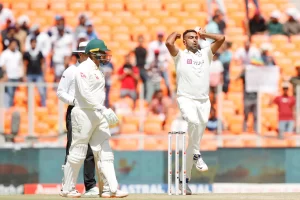
Even accounting for the fact that bowling has been easier than ever in Indian conditions this decade, Ashwin’s 6-91 in Ahmedabad showed why he’s right up there with the greatest spinners of all time.
When it comes to the narratives about Indian pitches, you’ll find more cliches than the average teledrama. Words like ‘featherbed’, ‘dustbowl’ and ‘bunsen burner’ are par for the course, and the chronicles often have very little to do with reality. What the facts and figures tell you is that India, perhaps on account of its sheer size and variations in climate, has offered up the kind of variety in surfaces that few other countries can boast of. You only have to look at the records of fast bowling greats like Dale Steyn and Glenn McGrath in Indian conditions to realise that generalisations about it being a country for only spinners and batters are way off the mark.
What is beyond dispute, however, is the sharp deterioration in the quality of Indian pitches in this decade. Rahu Dravid has cited the World Test Championship, and the pressure to gain points to make the final, as one of the reasons for ‘result-oriented’ pitches. There’s little doubt that that has been a contributory factor, but the pendulum has swung too far in one direction.
What we’ve seen in Ahmedabad so far is drastic course correction. Discounting the Australian run chase in Indore, which needed just 18.5 overs, this was the only the second time in 22 innings by visiting teams this decade that the third new ball has become available. Only four times had even the second new ball been due, with as many as seven innings wrapped up inside 50 overs.
Contrast that with the first decade of this century, which featured the Miracle of Eden Gardens and many other memorable Tests. India were eligible to take the third new ball on ten occasions then, while visiting teams batted past the 80-over mark 56 times. Only once, when Australia were shot out for 93 in 30.5 overs on a grossly underprepared Wankhede Stadium track, did an innings end inside 50 overs.
The 2010s weren’t all that different, though the surfaces became a lot more bowler-friendly towards the end of the decade. The third new ball became available four times, and visiting sides went past 80 overs on 51 occasions. There were 16 innings that lasted under 50 overs, but eight of them featured Afghanistan, Bangladesh and West Indies – teams that are either new to the format or haven’t challenged at the top end of Test cricket for decades.
What the past five years have done is dramatically skew the numbers. Previously, Test cricket in India was a game of patience, with bat and ball. Of the Indian bowlers with more than 150 Test wickets, only four have a strike-rate under 60. All of them – R Ashwin (51.6), Ravindra Jadeja (59.0), Mohammed Shami (49.7) and Umesh Yadav (51.8) – are playing in this Test.

Axar Patel’s 49 Test wickets have come at a strike-rate of 43.7. What do these numbers tell us? Are Shami and Umesh that much better than Kapil Dev, Zaheer Khan and Javagal Srinath? Do Ashwin and Jadeja put Anil Kumble, Harbhajan Singh and the legendary spin quartet of the 1970s in the shade? Or do their admittedly impressive numbers need to be viewed in the light of the fact that the surfaces are much more bowler-friendly?
For some perspective, let’s go back to the 1970s, when many of the lazy stereotypes about heat, dust and spin first grew deep roots. Of 62 opposition innings in that decade, 39 spanned more than 80 overs, with a third new ball being available on five occasions. Only once was a team skittled in under 50 overs, and that was a second-string West Indies at Chennai in 1979.
Bhagwat Chandrasekhar (97) and Bishan Singh Bedi (94) took nearly a century of wickets at home in the 1970s, when Tests were nowhere near as frequent as they are now. But they also had to bowl a lot of overs to get them. Contrary to accepted ‘wisdom’, the pitches weren’t snake pits where they just had to turn their arms overs to succeed.
In that sense, Ashwin can take great satisfaction from his display in Ahmedabad. With the pitch offering next to no assistance on the first two days, he had to summon up the sort of spell that the likes of Bedi, Chandrasekhar and Kumble would be all too familiar with. Plenty of patience, lots of skill and much thought going into the plotting of each dismissal.
On the kind of pitches that India have played on of late, it’s easy to disregard the skill of the bowler, and attribute every collapse to the surface. But the truly great bowlers, and Ashwin is undoubtedly one, manage to transcend the conditions and write their own scripts. Is he the best that India has ever had? It’s silly to compare across generations, especially when both pitches and aptitude against spin have changed so much within Ashwin’s own career. But even accounting for the fact that bowling has been easier than ever in this decade, he must be right up there in the conversation.



